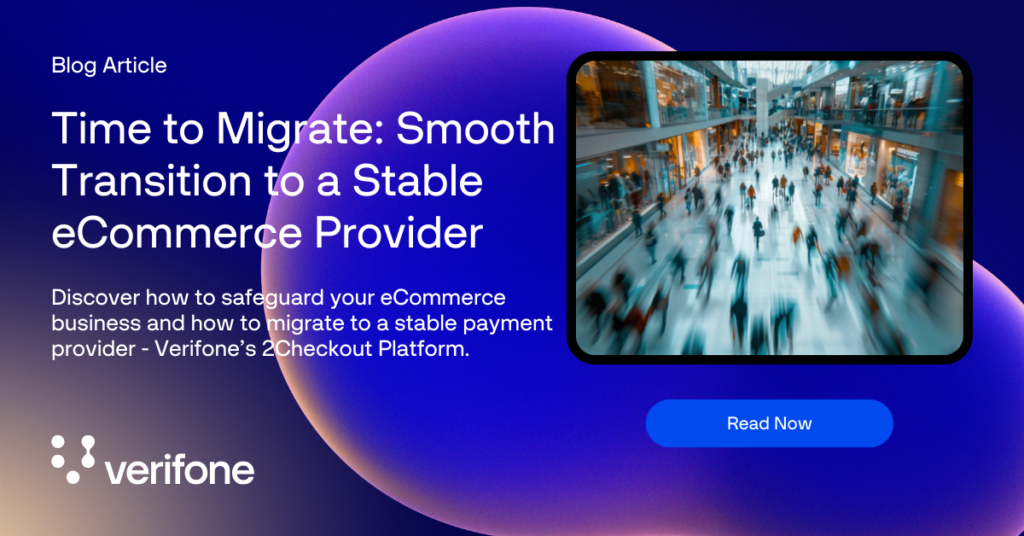The sudden shutdown of Digital River left many eCommerce and SaaS businesses facing significant challenges. Merchants lost access to their funds, customer data, and the ability to process transactions. For companies that relied on Digital River as their Merchant of Record, the disruption created uncertainty about how to move forward.
To address these concerns, 2Checkout and Verifone hosted a webinar featuring industry experts who provided insights into what led to the shutdown and what businesses should do next.
Himanshu Patel, CEO of Verifone, and Bart Damstra, General Manager of 2Checkout, shared guidance on:
- What really happened to Digital River and why it collapsed.
- The importance of data ownership and how to regain control of lost customer information.
- The viability of the Merchant of Record model moving forward.
- How businesses can quickly migrate to a new provider and resume operations.
- What to look for in a reliable, financially stable payment partner.
If your business was affected by the Digital River shutdown or if you are looking to future-proof your payment operations, read below for key takeaways from the webinar and the exact steps you need to take next.

What Really Happened to Digital River?
As Himanshu Patel explains, Digital River’s collapse was a fast-moving event and an unfortunate situation.
He points out that early warning signs appeared six to eight months before the shutdown, with some merchants experiencing delayed payouts, particularly smaller businesses that depend on a steady cash flow.
These disruptions signaled deeper financial instability.
Bart Damstra adds that the situation further escalated due to a combination of factors, including poor investment decisions, macroeconomic pressures, and regulatory challenges.
He adds that rising interest rates and financial mismanagement left Digital River unable to meet settlement payments, forcing them to use merchant funds to cover losses.
For many businesses, the shutdown created an immediate crisis. Without access to their funds or customer payment data, merchants found themselves unable to process transactions or migrate their operations elsewhere.
What Merchants Can Learn from This Shutdown
Himanshu highlights that businesses need to be more picky when choosing a payment provider. That’s because many assume their provider is financially stable until it is too late.
He also advises to keep an eye out for warning signs like:
- payout delays,
- leadership shake-ups, or
- a lack of clear communication about where funds are being held.
Bart adds that another major issue is data ownership. Many Digital River merchants believed they had full control over their customer and payment information, only to realize they couldn’t access it when they needed to switch providers.
He urges businesses to review their contracts carefully and ensure they have the ability to move their data if necessary.
The Real Cost of Being Locked Out of Your Own Data
For businesses running on a subscription model, the inability to access payment data was more than just a temporary issue.
Without customer billing details, they couldn’t process renewals, leading to lost revenue and frustrated customers.
Many large merchants affected by the shutdown discovered that even though they technically owned their subscriber data, Digital River wasn’t making it easy to retrieve.
While some had negotiated data ownership rights, they still struggled to export their information and move to a new provider.
Situations like this highlight why businesses need to work with a payment provider that guarantees full control over customer data and makes transitions easy when needed.
Bart highlights that 2Checkout has worked with businesses facing similar challenges, helping them recover their data and transition to a new provider without losing customers.
Businesses that take control of their data today – by ensuring full portability and working with a provider that supports easy transitions – will be in a much stronger position in the long run.
Read our Blog Article on how to safely migrate to a stable eCommerce Provider.
Does the Merchant of Record (MOR) Model Still Work?
After Digital River’s collapse, many businesses are asking the same question: Is the Merchant of Record (MOR) model still a safe option?
Some merchants lost access to their revenue overnight. Others, as mentioned earlier, struggled to retrieve customer data when they needed to migrate.
The situation has raised real concerns about relying too heavily on a single provider for global payments and compliance.
Was the Problem the Model or the Provider?
Patel explains that the MOR model itself is not the issue. Rather, the real problem was Digital River’s financial mismanagement.
The MOR model, when done right, is one of the simplest ways for businesses to manage global transactions. It handles tax compliance, fraud prevention, and payment processing in different countries, so merchants don’t have to deal with legal complexities. For many, it’s still an efficient way to scale internationally.
But as Bart points out, not all MOR providers operate the same way. Digital River’s failure wasn’t because of the model. It was because of how they managed merchant funds and contracts.
A Smarter Approach: Combining MOR with PSP
Some businesses are now looking for more flexibility by combining the MOR model with a Payment Service Provider (PSP).
Instead of relying on a single provider, a hybrid approach allows merchants to:
- Use MOR for international markets where tax compliance is complex;
- Leverage a PSP in their home country where they want more direct control over payment processing.
This setup means merchants can split transactions across multiple providers, ensuring they aren’t fully reliant on a single system. Himanshu emphasizes that Verifone and 2Checkout already support this model by acting as a technical gateway provider and giving businesses the ability to adjust based on their needs.
Watch our short video on how much a difference a flexible MoR approach could make.
What Businesses Should Do Next
Bart highlights three key takeaways for businesses reconsidering their payment model:
- Financial stability matters. Choose a provider with strong backing and regulatory oversight to avoid risky situations.
- Make sure you own your data. Some providers make it hard to migrate. Check your contracts to ensure full control over customer information.
- Keep your options open. If possible, diversify payment processing to reduce the risk of being locked into one provider.
Some merchants affected by Digital River’s shutdown are already making this shift. By diversifying their setup, they are ensuring that even if one provider fails, their revenue stream remains intact.
How Fast Can You Migrate and Resume Sales?
For businesses affected by the Digital River shutdown, time is critical. Every hour without a functioning payment system means lost revenue, frustrated customers, and operational setbacks.
Merchants need a fast, seamless transition to restore sales and keep their businesses running.

How Quickly Can a Business Recover?
During the session, Bart makes one thing clear: speed is everything. When payments stop, cash flow is immediately at risk, and businesses need to act fast to prevent long-term damage.
Some companies have managed to fully migrate in just a few days.
Bart shares a case where a large U.S.-based company reached out on a Friday morning, urgently needing to restore its online sales. Within hours, NDAs were exchanged, legal contracts were reviewed, and the technical team began working on the transition.
By Saturday night, development work was already underway, and at 2:30 AM on Sunday, final contract approvals were secured. By Monday morning, the business was live and processing transactions again.
A migration that fast isn’t just about moving data. It requires a payment provider with the right expertise, infrastructure, and industry connections to make the transition seamless.
Why Acting Fast Makes All the Difference
Bart warns that waiting too long comes with consequences. A delayed migration doesn’t just mean lost sales – it can trigger a ripple effect of disruptions that are harder to fix down the line.
- Customers lose trust. Failed payments and checkout issues frustrate buyers, leading to lost sales and lower retention;
- Subscription businesses face involuntary churn. If payments aren’t processed on time, recurring customers may not renew, cutting off future revenue;
- Operational bottlenecks build up. The longer a business delays, the more complicated and expensive the transition becomes.
For businesses impacted by the shutdown, speed is a competitive advantage. Those who migrate quickly can stabilize their operations while competitors are still struggling with disruptions.
What Merchants Should Look for in a Fast Migration
With that being said, Bart emphasizes that speed should never come at the cost of long-term stability.
Remember: Rushing into a provider without considering future needs can create more problems down the road.
He outlines three key priorities for businesses looking to migrate fast and stay secure:
- A provider with a track record of rapid migrations: Look for a team that has successfully onboarded businesses under tight timelines.
- Minimal customer disruption: A seamless transition should keep payment processing smooth so customers don’t experience failed transactions or service interruptions.
- Post-migration optimization: Getting back online is step one. Afterwards, businesses need to fine-tune approval rates, reduce churn, and optimize performance.
Himanshu notes that in many cases, having the right migration support can mean the difference between weeks of uncertainty and a fully operational business in days.
Choosing a Reliable Payment Provider Moving Forward
The Digital River shutdown is a great reminder that not all payment providers are built to last. When a provider fails, merchants don’t just lose access to payments; they risk losing customer trust, business continuity, and revenue stability.
For businesses looking to avoid this kind of disruption, it’s not enough to choose a provider based on features alone. Stability, transparency, and long-term security should be at the top of the list.

Why Financial Stability Matters
As Himanshu puts it: a provider’s financial health should be a non-negotiable priority.
The collapse of Digital River happened because of internal mismanagement, not external forces. That’s why choosing a provider with strong financial backing and regulatory oversight is critical.
What does that actually mean?
A reliable payment partner should:
- Be financially secure. A provider that relies on risky investments or unclear funding models is a red flag.
- Operate under strict regulations. A licensed, compliant provider is held to higher standards, reducing the risk of mismanagement.
- Have a clear business model. If a provider’s revenue strategy isn’t transparent, merchants should take a closer look before committing.
Himanshu adds that Verifone is regulated by the Dutch National Bank and three other financial authorities, ensuring merchant funds always remain protected.
If You Don’t Own Your Data, You Don’t Own Your Business
As mentioned before, for many merchants, the biggest shock after Digital River’s shutdown wasn’t just losing payments; it was losing access to their own customer data.
Bart stresses that this should never happen. Businesses need full control over their data, including customer payment records, subscription details, and transaction history.
A provider that truly focuses on merchant success should:
- Allow full access to customer and payment data at all times, with no restrictions;
- Make migrations easy rather than creating barriers to switching providers;
- Be transparent about contract terms so merchants know exactly what they’re signing up for.
Businesses that were locked out of their own subscription data after Digital River’s shutdown were forced to rebuild from scratch.
This is why Himanshu emphasizes that choosing the right provider is about more than just rates and features – it’s about ensuring business continuity.
What to Look for in a Reliable Payment Provider
For merchants that are re-evaluating their options, Bart lays out a simple but effective checklist:
- Regulatory compliance. Work with a provider that is licensed and operates under strict financial oversight.
- Proven track record. A history of stable operations and responsible fund management is key.
- Data transparency. Merchants should always have access to their own data, with no hidden restrictions.
- Scalability and flexibility. The best providers offer both MOR and PSP models, allowing businesses to scale while maintaining control.
Some merchants affected by Digital River’s shutdown are already shifting to a multi-provider strategy, using a combination of MOR and PSP to reduce risk. Others are choosing providers with stronger financial safeguards to ensure they never face this kind of uncertainty again.
What’s Next? Watch The Full Webinar
The lessons from Digital River’s shutdown are clear: merchants must take control of their data, choose financially stable providers, and have a migration strategy in place before a crisis happens.
This article covers the key takeaways, but there’s more to learn.
Get the full expert breakdown on navigating payment provider risks, migrating without disruption, and future-proofing your payment infrastructure.
to hear directly from Himanshu Patel and Bart Damstra they share practical strategies to keep your business secure and running smoothly.
Watch the full webinar for free!








